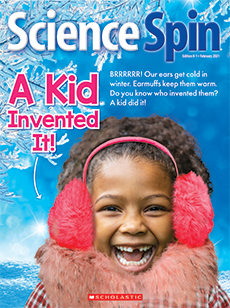May/June 2024
Let it Glow!
Academic Standards
Reading Objective:
Students will recognize that objects can be seen only when illuminated. They will apply this concept to bioluminescent ocean animals—visible because they make their own light.
Next Generation Science Standards:
K-LS1-1: What animals need to survive
1-PS4-2/4: Objects can be seen only when illuminated/light can be used to communicate
Vocabulary:
predator, bioluminescent
Use your Science Spin to find the best answer to each question.
1. What can the jellyfish do if a predator comes?
(It can flash its bright lights.)
2. It can flash its bright lights.
(shrimp)
3. How does the anglerfish catch food?
(It uses a blinking light under its eye.)
4. Draw your favorite glowing animal from the article.
(Answers will vary.)
Go online to print or project the Reading Checkpoint.
- As scientists use technology to dive deeper into the dark bottom of the sea, they have learned that MOST deep-sea animals are bioluminescent. They glow.
- That’s not all! Scientists are also discovering that a surprising number of mammals some mice, koala bears, and bats—glow in the dark when you shine a special black-light flashlight on them.
Materials: a windowed classroom filled with objects, pencils, copies of the skill sheet
Overview: We need light to see. Students learned that bioluminescent animals are visible in the dark sea because they make their own light. Here, kids survey their own environment to see which objects make their own light and which ones don’t.
Directions:
- Remind kids that we need light to see. Light can come from a source like a lamp that we use to see the words and pictures in a book.
- The lamp is a source of light. It makes its own light. Which other objects make their own light? Which objects don’t make their own light but rely on something like a lamp so we can see it?
- Tell kids they’ll be detectives to identify which objects around them make their own light, and which don’t.
- Pass out the skill sheets. Kids work individually, or in teams, recording answers on the skill sheets.
- Share results if there’s time. Kids can share any of their own observations too!
